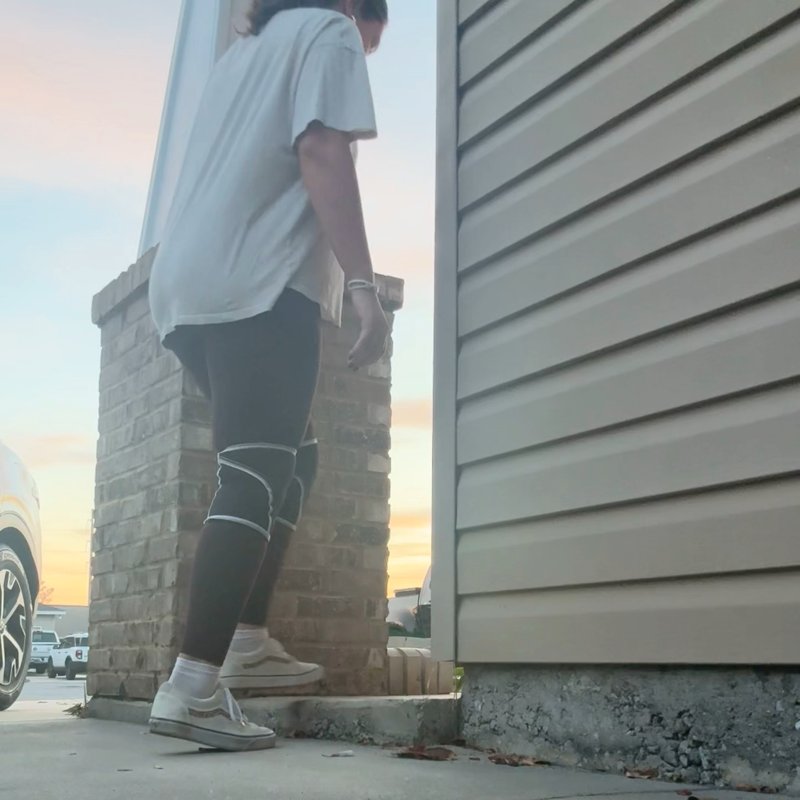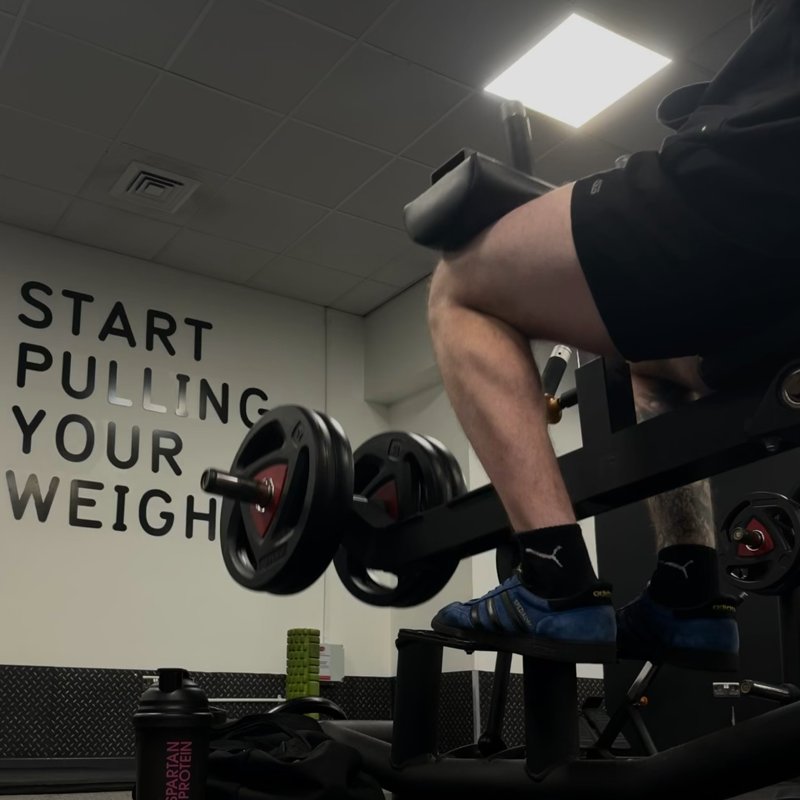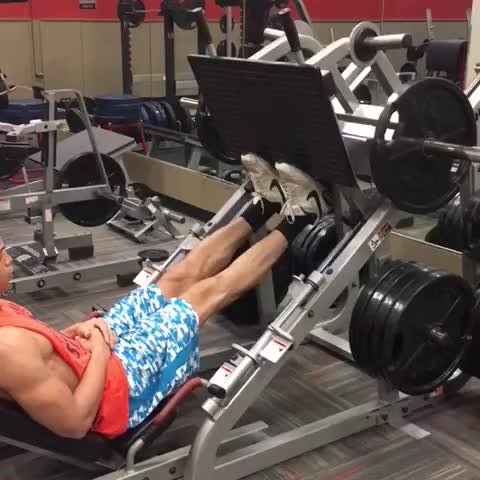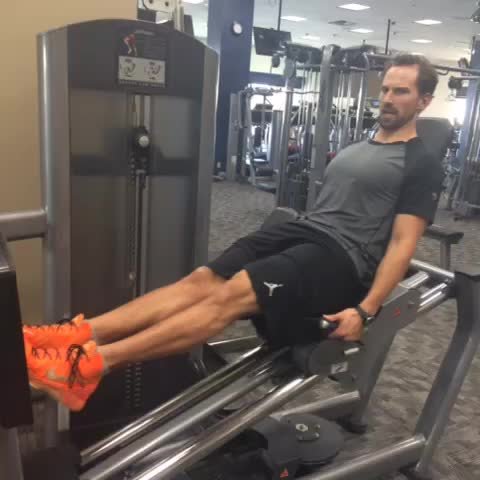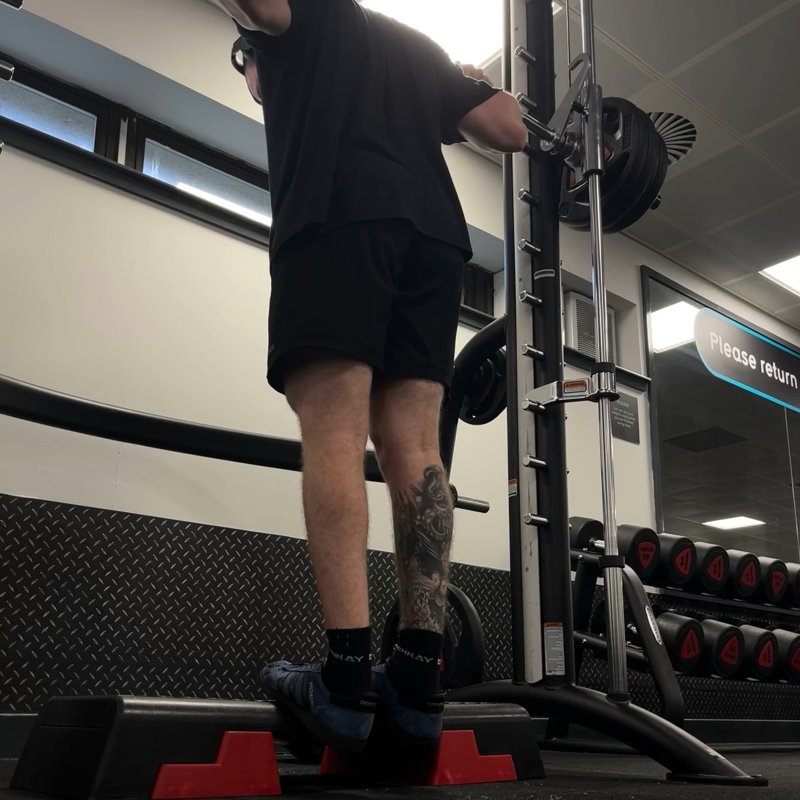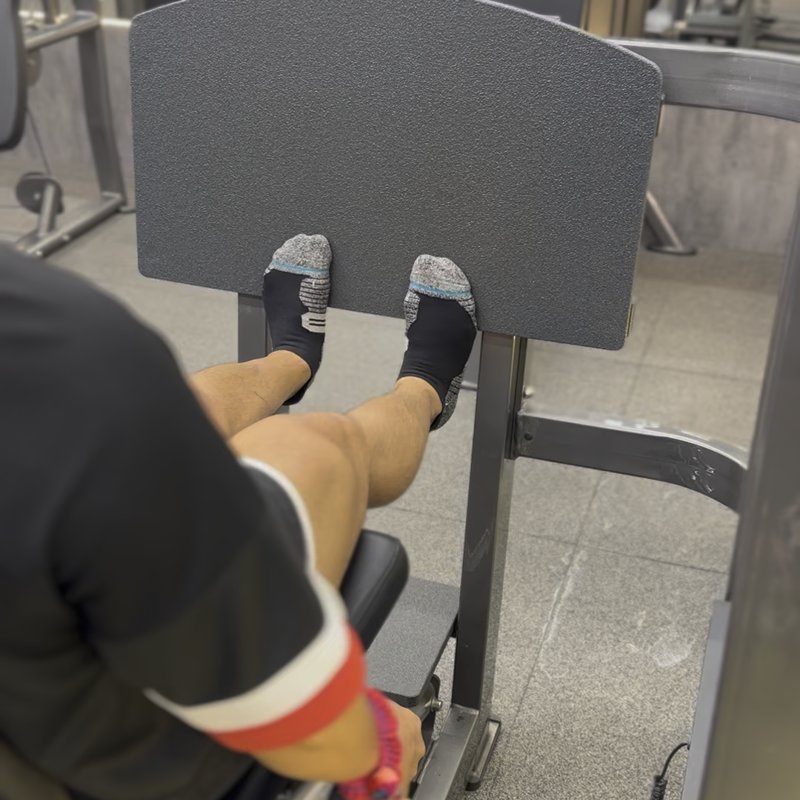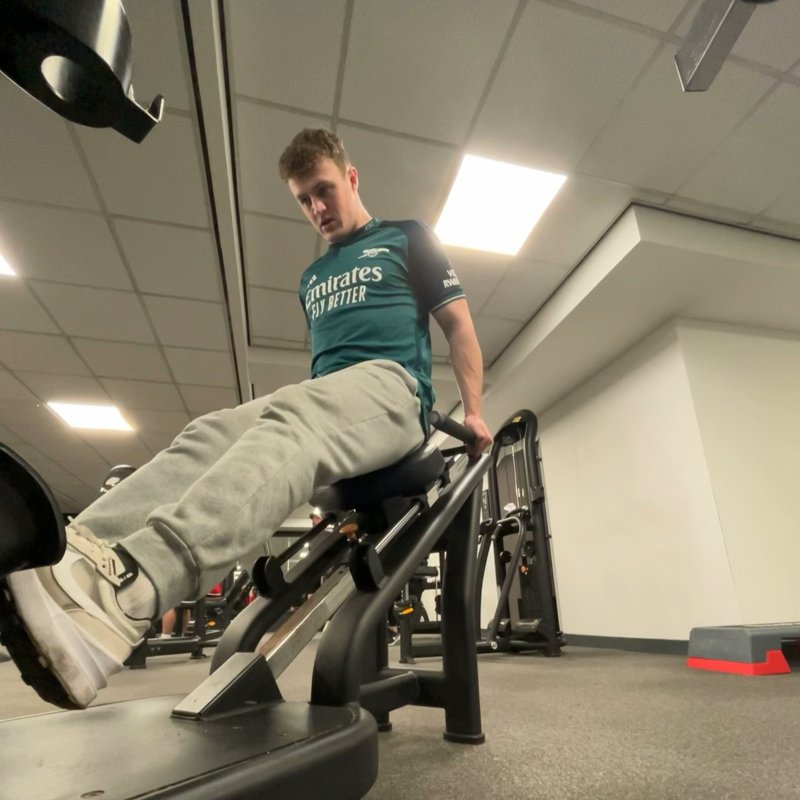Standing Calf Raise: The Ultimate Guide
The Standing Calf Raise is a targeted lower leg exercise that primarily works the gastrocnemius (the larger, visible calf muscle) through plantar flexion of the ankle, helping to build calf strength, size, and endurance.
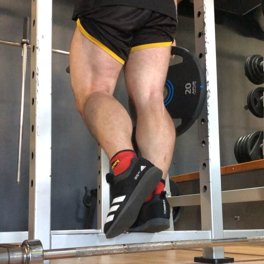
Quick Facts
Key Benefit
Gastrocnemius development and ankle strength
Primary Muscles
Secondary Muscles
Posterior Deltoids
Equipment
machine (optional), bodyweight, dumbbells (optional)
Difficulty
Beginner
Type
Strength
In This Guide
Ready to master the Standing Calf Raise?
Track your progress, see improvements over time, and build strength consistently.
Download GravitusThe Standing Calf Raise is one of the most effective exercises for developing the gastrocnemius muscle—the diamond-shaped muscle that forms the bulk of your visible calf. This movement specifically targets the lower legs through plantar flexion (pointing the toes downward), working the calves through their full range of motion. While often overlooked in favor of larger muscle groups, strong, well-developed calves provide numerous benefits beyond aesthetics. They improve athletic performance in activities requiring explosive power like jumping, sprinting, and direction changes. They also contribute to better ankle stability, potentially reducing injury risk during sports and everyday activities. The standing version of the calf raise specifically targets the gastrocnemius due to the straightened knee position, which places this muscle under optimal tension. When the knee is straight, the gastrocnemius is fully engaged in plantar flexion, unlike seated variations that emphasize the deeper soleus muscle. Whether performed with bodyweight on an elevated surface, with free weights for added resistance, or on specialized machines, the standing calf raise can be adapted for any fitness level. It requires minimal time and equipment while delivering significant benefits for lower leg strength, stability, and appearance. For complete calf development, the standing calf raise deserves a prominent place in your lower body training routine.
Benefits of Standing Calf Raises
The standing calf raise offers several important benefits for lower body development and athletic performance.
Calf Muscle Development
Directly targets the gastrocnemius muscle, helping to build visible muscle size and definition in the back of the lower leg.
Ankle Strength and Stability
Strengthens the muscles controlling ankle movement, potentially reducing risk of ankle sprains and improving balance.
Athletic Performance
Enhances explosive power for jumping, sprinting, and other activities that rely on ankle plantar flexion for force generation.
Improved Posture
Stronger calves help support proper foot mechanics, which can contribute to better overall posture and alignment.
Accessibility
Can be performed almost anywhere with minimal or no equipment, making it easy to incorporate into any fitness routine.
Proper Form & Technique
Setup
- Stand on an elevated surface (step, platform, or calf raise machine) with the balls of your feet on the edge.
- Position your feet hip-width apart with toes pointing forward (or slightly outward for comfort).
- Allow your heels to hang off the edge of the platform.
- If using a calf raise machine, position shoulders under the pads; if using free weights, hold dumbbells at your sides.
- Stand tall with chest up, shoulders back, and core engaged.
- For balance, you may lightly hold onto a stable surface with your fingertips if needed.
Movement
- Begin by lowering your heels toward the floor, creating a stretch in your calf muscles.
- Continue lowering until you feel a distinct stretch in your calves without straining.
- Pause briefly at the bottom of the movement to maximize the stretch.
- Push through the balls of your feet to raise your heels as high as possible.
- Rise until you're standing on your tiptoes with calves fully contracted.
- Hold the contracted position briefly (1-2 seconds) at the top of the movement.
- Slowly lower your heels back down to the stretched position with control.
- Repeat for the desired number of repetitions, maintaining a controlled tempo throughout.
Key Form Tips
Range of Motion
Focus on full range of motion - from a complete stretch at the bottom to a full contraction at the top.
Controlled Movement
Avoid bouncing or using momentum; the movement should be slow and controlled in both directions.
Balance
Maintain your center of gravity over the middle of your feet to ensure stability throughout the exercise.
Mind-Muscle Connection
Focus mentally on your calf muscles working during each repetition to maximize engagement.
Foot Position
Experiment with foot position - toes straight ahead targets the central portion of the calves, while slightly angled feet shift emphasis to inner or outer portions.
Muscles Worked
Primary Muscles
- gastrocnemius: The large, diamond-shaped muscle that forms the visible bulk of the calf, primarily responsible for plantar flexion when the knee is straight.
Secondary Muscles
- soleus: A flat muscle located beneath the gastrocnemius that assists in plantar flexion, though it's more heavily engaged when the knee is bent.
- plantaris: A small muscle that works with the gastrocnemius to plantarflex the ankle.
- posterior deltoids: A deep muscle that helps stabilize the ankle during the movement.
- flexor hallucis longus: Assists with plantar flexion while also helping to stabilize the big toe during the movement.
Common Mistakes and How to Fix Them
Insufficient Range of Motion
Not lowering the heels enough or not rising fully onto the toes limits muscle development. Focus on achieving a complete stretch at the bottom and full contraction at the top of each repetition, even if it means using less weight.
Using Momentum
Bouncing at the bottom or using body momentum reduces calf engagement and effectiveness. Maintain controlled movement throughout the exercise, pausing briefly at both the top and bottom positions to eliminate momentum.
Leaning Forward
Excessive forward lean can take tension off the calves and place stress on the lower back. Keep your torso upright with shoulders stacked over hips, and core engaged throughout the movement.
Knees Bending
Allowing the knees to bend during the exercise shifts focus from the gastrocnemius to the soleus. Keep your knees straight (but not forcefully locked) throughout the movement to maximize gastrocnemius engagement.
Foot Position Too Wide or Narrow
Improper stance width can affect balance and muscle recruitment. Start with feet hip-width apart, toes pointing forward or slightly outward, and adjust based on comfort and stability.
Standing Calf Raise Variations
Equipment Variations
-
Bodyweight Calf Raise
Performed on a step or platform using only body weight, ideal for beginners or high-rep endurance work.
-
Dumbbell Calf Raise
Holding dumbbells at your sides for added resistance, allowing for progressive overload as strength increases.
-
Barbell Calf Raise
Using a barbell across the upper back for more substantial loading, typically performed in a squat rack for safety.
-
Machine Calf Raise
Using a dedicated calf raise machine with adjustable weight, providing stability and consistent resistance throughout the movement.
Technical Variations
-
Single-Leg Calf Raise
Performing the exercise on one leg at a time to address muscle imbalances and increase the challenge on each leg.
-

Pulsed Calf Raise
Using small, pulsing movements at the top of the range of motion to increase time under tension and muscle fatigue.
-

Tempo Calf Raise
Manipulating the speed of different phases (e.g., 3 seconds up, 1 second hold, 3 seconds down) to increase time under tension.
-

Angled Foot Calf Raise
Intentionally turning toes inward or outward to shift emphasis to different portions of the gastrocnemius.
Frequently Asked Questions
For most people, training calves 2-3 times per week with at least 48 hours between sessions provides optimal stimulus for growth while allowing sufficient recovery. The calves consist predominantly of slow-twitch muscle fibers in most individuals, which typically respond well to higher frequency training with moderate volume. If your calves are a prioritized area for development, you might consider dividing your weekly volume into 3-4 smaller sessions rather than 1-2 larger ones. For maintenance, even once-weekly dedicated calf training can be effective if you're performing other activities that indirectly work the calves, such as running, jumping, or other lower body exercises.
Calves can be challenging to develop for several reasons. First, they contain a high proportion of slow-twitch muscle fibers in many individuals, which have less growth potential than fast-twitch fibers. Second, calves are used extensively in daily activities like walking and standing, making them already adapted to endurance work. Third, calf muscle development has a significant genetic component, with factors like muscle insertion points and fiber type distribution heavily influenced by heredity. To overcome these challenges, consistent training with progressive overload, full range of motion, variety in repetition ranges, and diverse foot positions is essential. For stubborn calves, consider higher volume approaches (12+ sets weekly) with varied training methods to stimulate all fiber types.
Neither is inherently "better" - they target different muscles and complement each other well. Standing calf raises primarily target the gastrocnemius (outer, visible calf muscle) because this muscle crosses both the ankle and knee joints, functioning optimally when the knee is straight. Seated calf raises emphasize the soleus (the flatter muscle underneath the gastrocnemius) because this muscle only crosses the ankle joint and is more engaged when the knee is bent. For complete calf development, incorporating both variations is ideal. If you must choose one, select based on your goals - standing raises for visible calf size and athletic performance, seated raises for lower leg endurance and deeper muscle development.
Calves typically respond well to varied repetition ranges that target different muscle fiber types. For strength development, perform sets of 6-10 repetitions with heavier weights. For hypertrophy (muscle growth), sets of 10-15 repetitions with moderate weights are effective. For endurance and targeting slow-twitch fibers, higher repetition ranges of 15-30 can be beneficial. Many successful calf development programs incorporate all three ranges within a training cycle. Given calves' recovery capacity, higher overall volume is often beneficial - consider 12-16 total sets per week divided across 2-3 training sessions. Regardless of rep range, emphasize complete range of motion and controlled tempo for optimal results.
Video Demonstrations
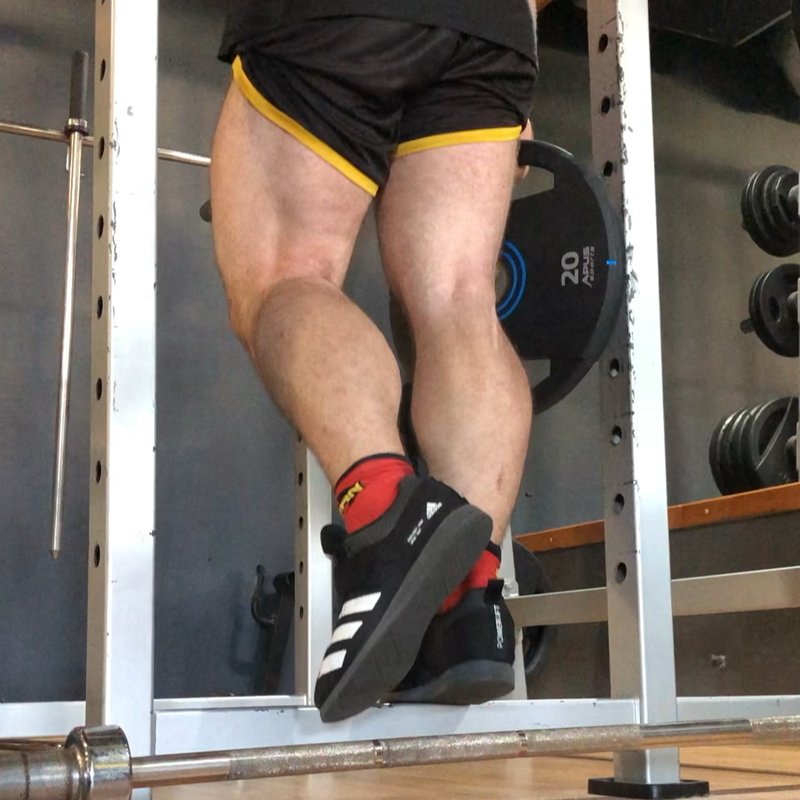
Log in to watch video demonstrations
Login to Watch2 video demonstrations available
Tips from the Community
-

Don't think about your feet. Just get your heels up as high as you can.
-

Keep the weight on the ball of your foot.
-

Slow controlled movements, full range of motion, pause at the top
-

1. Deep stretch in the bottom, pause, so as to ensure you engage with the target muscle rather than being a bouncey boiiii. 2. Use the cue of “ankles forward” to help with peak contraction.
-

Focus on that contraction, baby.
Track your progress with Gravitus
Download Gravitus to log your workouts, track your progress, and join a community of fitness enthusiasts.

Helpful Resources
One Rep Max Calculator
Find your one rep max for any exercise without maximal testing. Essential for developing effective strength training programs.
Calculate 1RMWorkout Programs
Follow structured workout programs created by fitness professionals to maximize your strength and muscle gains.
View Programs